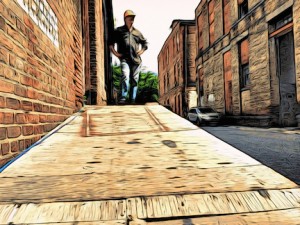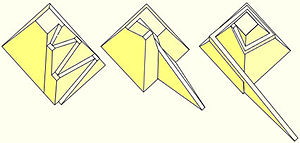Information on the Internet about the construction of the great cities and monuments of the Mesoamerican and South American cultures is surprisingly hard to find, it turns out.
 The Aztecs were real tricky to find stuff on. Almost every supposed “source” detailing its construction techniques immediately starts going on about how they sacrificed people during construction, then doesn’t bother to actually discuss the techniques they used. I’m no trained historian, but that seems like sensationalism to me, and it sure doesn’t answer my questions.
The Aztecs were real tricky to find stuff on. Almost every supposed “source” detailing its construction techniques immediately starts going on about how they sacrificed people during construction, then doesn’t bother to actually discuss the techniques they used. I’m no trained historian, but that seems like sensationalism to me, and it sure doesn’t answer my questions.
There are a few interesting tidbits out there, though. Teotihuacan, one of the major Aztec sites, was actually constructed over a thousand years before the Aztecs gained power, by someone else entirely.
The Inca and Mayan empires have a bit more out there to easily find. I had to dig through a lot of nonsense about Mayan prophecies and their mass disappearance, but there was a lot of good stuff. Like this: They actually used a primitive form of limestone-based concrete for much of their construction.
 The Incans were the easiest to find information on, since most of the stuff on the Internet is about their construction techniques anyhow. Their buildings were famed for being constructed of huge stone blocks in irregular patterns that for together perfectly, without gaps. You can’t even stick a knife between the stones.
The Incans were the easiest to find information on, since most of the stuff on the Internet is about their construction techniques anyhow. Their buildings were famed for being constructed of huge stone blocks in irregular patterns that for together perfectly, without gaps. You can’t even stick a knife between the stones.
People go crazy over that, some even going so far as to say that there were aliens helping the Incans. (Some nuts out there.) I think it says more about contractors today than it does about ancient construction. Tight seams just take good workmanship.
The stones in Incan constructions were placed by dragging them up huge earthen ramps on log rollers. Interestingly enough, they took the opposite approach to the ramps than the Egyptians, who just put together giant straight ramps. The reason they could do that when the Egyptians couldn’t is pretty simple: the Incan Empire was huge. It was basically the Rome of South America. It could afford to just throw manpower at problems until they were solved.
They did save a little money by using locally quarried limestone or granite, but the empire was wealthy and powerful enough that it could have shipped them halfway across Peru on their excellent system of roads if the whim overtook them. We have tons of archaeological evidence for the Incan ramps, and a few—even still—partially exist.
 I had a brand new Schwinn, and he had one of those heavy black Raleigh bikes from England. The boards were resting on the cinder block at about a 45-degree angle. I went first, on account of John being quite a bit smarter than me. I moved right up against his house to get the fastest start I could. I came at the ramp straight on and made it onto the board I was aiming at, which then promptly broke in half, and I crashed full speed into the cinder blocks.
I had a brand new Schwinn, and he had one of those heavy black Raleigh bikes from England. The boards were resting on the cinder block at about a 45-degree angle. I went first, on account of John being quite a bit smarter than me. I moved right up against his house to get the fastest start I could. I came at the ramp straight on and made it onto the board I was aiming at, which then promptly broke in half, and I crashed full speed into the cinder blocks. John, meanwhile, hadn’t bothered to watch me go down. When he saw me ramp, he just had to go himself. He used a different, longer board than I did. As soon as his back wheel hit the end of the board, it flipped up into the air like it were part of a catapult, flew through the air, and somehow managed to land on one end on my injured arm between the wrist and elbow, breaking it a second time before bouncing farther down the hill.
John, meanwhile, hadn’t bothered to watch me go down. When he saw me ramp, he just had to go himself. He used a different, longer board than I did. As soon as his back wheel hit the end of the board, it flipped up into the air like it were part of a catapult, flew through the air, and somehow managed to land on one end on my injured arm between the wrist and elbow, breaking it a second time before bouncing farther down the hill. The ancient Egyptians obviously didn’t have the technology for moving heavy loads that we did. All they had were a few primitive cranes, some basic levers and rollers, and, of course, ramps.
The ancient Egyptians obviously didn’t have the technology for moving heavy loads that we did. All they had were a few primitive cranes, some basic levers and rollers, and, of course, ramps. It seems more likely that they instead either zigzagged the ramp up one side or spiraled it around the pyramid, using uncompleted segments as the ramp. This would have allowed them to construct the vast majority of the pyramid easily, though the top third of the structure would have needed to be moved up, using levers. Since it’s so much narrower at the top, though, that top third makes up less than five percent of the total weight of the pyramid. That’s working smart.
It seems more likely that they instead either zigzagged the ramp up one side or spiraled it around the pyramid, using uncompleted segments as the ramp. This would have allowed them to construct the vast majority of the pyramid easily, though the top third of the structure would have needed to be moved up, using levers. Since it’s so much narrower at the top, though, that top third makes up less than five percent of the total weight of the pyramid. That’s working smart.